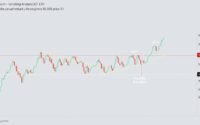TA: Bitcoin Just Broke $13.8K and It’s Likely to Surge Past $14K
Surprising fact: bitcoin topped an intraday peak above $123,000 in 2025 before settling near $119,800, a signal of deepening momentum in the US crypto scene.
The jump reflects more than short-term excitement. U.S. spot bitcoin ETFs logged a $1.18 billion inflow on a single day in 2025, and combined ETF assets now exceed $158 billion. That flow is widening access and liquidity for retail and institutional investors alike.
Policy is catching up. House hearings during U.S. “Crypto Week,” including consideration of the GENIUS Act, have created clearer outlines for stablecoins and market rules. That regulatory visibility is a key tailwind for confidence.
Major managers such as Fidelity and Franklin Templeton are expanding ETF options, shifting how people approach custody and investment. Analysts also note a changing cycle dynamic that could mean milder drawdowns and faster recoveries.
In this article, we will unpack the breakout, examine ETF flows and U.S. policy, explore the evolving cycle, and outline investor scenarios and risks.
Key Takeaways
- Record momentum: Bitcoin’s intraday highs signal strong demand and market depth.
- ETF inflows and $158B AUM show growing institutional participation.
- U.S. policy moves like the GENIUS Act improve regulatory clarity.
- Blue-chip ETFs simplify access versus direct coin custody for many investors.
- Market cycles may be shifting toward shallower, quicker corrections.
ta-bitcoin-just-broke-13-8k-and-its-likely-to-surge-past-14k: what today’s breakout signals for price, demand, and market momentum
Recent flows into spot products have reshaped the mechanics behind bitcoin’s highs. With bitcoin briefly topping new multi-year levels in 2025, the move aligns with record ETF inflows and clearer U.S. policy attention.
Demand now looks structural: programmatic buying from ETFs and steady corporate allocations mean higher highs are less tied to fast speculative spikes and more to ongoing purchases by long-term holders.
Momentum is confirmed by a sequence of higher closes near peaks, not just intraday spikes. That pattern suggests market interest at elevated price levels is persistent for the time being.
- Timing shift: all-time highs arrived before the 2024 halving, highlighting ETF-led flows as a dominant driver.
- Investor mix: institutions and corporate treasuries are growing, which can dampen volatility vs. retail-led runs.
- Liquidity: liquid ETFs compress frictions, tighten spreads, and support price discovery during heavy sessions.
| Metric | Recent Signal | Implication |
|---|---|---|
| Demand | Consecutive large ETF inflows | Structural buying supports sustained price |
| Momentum | Higher highs & firm closes | Reduced chance of instant reversal |
| Investor Composition | Institutional & corporate increases | Longer time horizon, lower retail volatility |
Risks remain: macro shocks or policy surprises could interrupt the run. Overall, price bitcoin dynamics today are being shaped more by regulated rails and institutional behavior than by past retail-driven cycles.
ETF inflows and U.S. “Crypto Week” policy tailwinds are redefining the bitcoin market
Record ETF subscriptions are anchoring demand and rewriting price signals for bitcoin. U.S. spot bitcoin etfs logged a single-day inflow of $1.18 billion and now hold more than $158 billion in aggregate assets. Those figures matter because they move dollars into regulated vehicles that execute in spot markets.

Why institutional funds change price discovery
Large funds give pension plans, RIAs, and corporates a clear path to exposure. Daily liquidity, audited NAVs, and custody reduce operational risk. That transparency tightens spreads and supports firmer bids during high-volume sessions.
Crypto Week and the GENIUS Act
The House debate over stablecoin rules, clearer federal roles, and a ban on a Fed digital asset lowers regulatory uncertainty for exchanges and the industry. Predictable rules make it easier for brokers and retirement platforms to offer access.
Distribution, supply, and demand
Major providers like Fidelity and Franklin Templeton widened distribution last month. Analysts estimate institutions bought about $15 billion in bitcoin funds over 6–8 weeks while retail remained mostly on the sidelines.
| Signal | Data | Market impact |
|---|---|---|
| Single-day inflow | $1.18B | Immediate bid support |
| Aggregate AUM | $158B+ | Sticky, rebalanced capital |
| Institutional purchases | ~$15B (6–8 weeks) | Lower volatility, longer horizons |
| Policy clarity | GENIUS Act & oversight debates | Reduced compliance uncertainty |
Risk note: tariff-driven inflation could keep interest rates high and temper appetite despite durable institutional demand.
Breaking the four-year cycle? How ETF-driven demand front-ran the post-halving rally
ETF demand rewired timing for returns, producing highs earlier than classic halving cycles predicted. Analysts flagged that bitcoin reached a record high above $73,000 in March 2024 before the April halving, then broke higher above $120,000 in 2025. That sequence signals liquidity-sensitive behavior.
All-time highs before the 2024 halving
Instead of peaking long after a halving, highs came early in 2024. This suggests that etfs and regulated wrappers can front-run traditional cycle milestones by moving large pools of capital into the spot market.
Volatility and drawdowns
Experts like Bitwise CIO Matthew Hougan argue the old 70–80% crashes are less likely as bitcoin matures. He and others expect future corrections closer to 30–50% as deeper liquidity and diversified investment channels support faster mean reversion in price.
Macro and regulation
Timing still matters. CoinDesk data shows past cycles peaked 500–720 days after halving, so acceleration could land between Q3 2025 and early Q1 2026. However, interest-rate paths and tariff-driven inflation pose material risk.
- Supply is thinner post-halving, so new allocations have amplified impact on market price bitcoin.
- Industry oversight from “Crypto Week” may lower uncertainty and make bitcoin more institutional as an asset for portfolios.
- Even with structural demand, sharp corrections remain possible; the difference is shorter, quicker recoveries rather than prolonged drawdowns.
“Four-year cycle dynamics appear to be evolving as regulated flows and long-term holders change the market’s response to supply and demand.”
What this means for U.S. investors: scenarios, risks, and potential highs
U.S. investors now face clearer scenarios as ETF-led flows and corporate treasuries reshape market dynamics. Near-term targets and the path there depend on continued institutional buying, congressional clarity, and macro conditions.
Upside case: Sustained allocations from large funds and corporate balance sheets could push bitcoin toward $125,000 in the next month or two. Some market strategists set year-end targets between $140,000 and $160,000 if the recent $15 billion of institutional purchases and steady daily funds inflows continue.
How investors can position: Use regulated spot vehicles and disciplined rebalancing to gain exposure while managing volatility. Regulated exchange-traded wrappers improve execution and custody, lowering operational friction for retail and institutional investment.
- Liquidity venues: deeper ETFs compress spreads and improve execution quality.
- Time and flow: institutions often act on quarterly mandates, creating lumpy inflows around month or quarter ends.
- Portfolio framing: treat bitcoin as a high-volatility growth asset and size positions to match risk tolerance.
Risk case: Tariff-driven inflation could keep rates elevated, pressuring risk assets and trimming multiples. Policy surprises during ongoing debates over rules like the GENIUS Act could also dent sentiment, creating sharp but potentially short-lived drawdowns.
| Scenario | Key catalysts | Potential outcome |
|---|---|---|
| Upside | Institutional inflows, fund approvals, corporate buys | Targets: $125k short-term; $140k–$160k year-end |
| Risk | Hawkish Fed, tariff inflation, regulatory shock | Interim drawdowns despite structural demand |
Watch list: daily fund flows, congressional moves, and macro prints (inflation, jobs). These signals will help investors decide whether to add, trim, or rebalance exposure as the current surge unfolds.
Conclusion
The combination of large inflows and policy clarity has pushed bitcoin into a different regime of price discovery. The 2025 intraday record high near $123,000 and the $158 billion held in U.S. spot products show institutional channels now lead major moves.
Steady etfs and bitcoin etfs flows, including the $1.18 billion peak day, have amplified the recent surge. That shift turns short-term rallies into trend-supporting liquidity.
Policy progress from Crypto Week, including debate around the GENIUS Act, improves the outlook for crypto infrastructure and bank participation. Still, macro risks such as tariff-driven inflation could temper appetite and affect price.
For U.S. investors, the path forward is clear: track daily inflows, legislative developments, and liquidity conditions. Use regulated vehicles, size positions to risk tolerance, and stay disciplined as the surge unfolds.
FAQ
What does the recent Bitcoin breakout above ,800 mean for price momentum?
The move above ,800 signals renewed buying interest and short-term momentum. Institutional inflows into spot Bitcoin ETFs and stronger dollar-denominated demand have tightened effective supply on exchanges. That combination often supports further price gains, but momentum can reverse quickly when volatility spikes or macro news shifts.
How do ETF inflows affect Bitcoin’s price and market structure?
ETF inflows bring predictable, durable demand from institutions and retail platforms. Funds from Fidelity, BlackRock, and others convert cash into ETF shares, which can reduce exchange-listed supply and improve price discovery. Larger inflows also deepen liquidity and attract more market makers, lowering trading frictions.
What is “Crypto Week” and why could it matter for Bitcoin?
“Crypto Week” refers to concentrated legislative and regulatory activity in Congress and federal agencies, including bills like stablecoin frameworks. Clearer rules reduce regulatory uncertainty, encourage institutional participation, and can boost exchange listings and ETF interest, which may support prices over time.
Are mainstream ETFs lowering investor risk for crypto exposure?
Yes. ETFs from established asset managers offer regulated custody, audited holdings, and oversight that many investors find safer than self-custodied or unregulated products. That lowers perceived counterparty and custody risk, expanding the pool of potential buyers.
How does limited Bitcoin supply interact with rising ETF demand?
Bitcoin’s capped supply means sustained large inflows can create a supply-demand imbalance. When inflows accelerate, available sell-side liquidity on exchanges can dwindle, pushing prices higher until miners or long-term holders supply more coins or demand eases.
Is this breakout a sign that the four-year halving cycle is changing?
It’s early to declare a structural change, but ETF-driven demand has front-run some traditional post-halving patterns. Historically, halving reduced miner issuance and later supported rallies. Now, liquidity-sensitive buying from ETFs can compress the timeline, producing earlier highs in some cycles.
Will Bitcoin volatility and large drawdowns disappear with ETF adoption?
Not entirely. ETFs reduce some frictions and bring stabilizing flows, but crypto remains sensitive to macro shocks, policy shifts, and liquidity shifts. Expect continued volatility and occasional sharp corrections, though the amplitude and duration of drawdowns may evolve.
How do interest rates and regulatory moves shape Bitcoin’s outlook?
Higher interest rates can pressure risk assets, including Bitcoin, by raising the opportunity cost of holding non-yielding assets. Conversely, clearer regulation can unlock capital by reducing legal and operational risk. The net effect depends on the balance between monetary policy and favorable regulatory clarity.
What are realistic upside targets if institutional adoption continues?
Bull-case scenarios often cite six-figure targets driven by corporate treasuries and sustained ETF demand. Analysts differ, but continued institutional flows combined with limited supply can push mid- to high-five-figure targets and, in some models, toward 5k–0k over multi-year horizons.
What are the main downside risks U.S. investors should monitor?
Key risks include adverse regulatory rulings, sudden policy changes, aggressive rate hikes, geopolitical shocks, or a collapse in ETF demand. These events could trigger rapid outflows and steep price corrections, so risk management and position sizing remain crucial.
How should retail investors approach exposure to Bitcoin given current dynamics?
Retail investors should set clear goals, use dollar-cost averaging if uncertain, and prefer regulated vehicles like spot ETFs if custody or security is a concern. Maintain diversified portfolios and prepare for high volatility by sizing positions to withstand drawdowns.
Where can I track ETF inflows and related market data?
Monitor fund reports from issuers like BlackRock, Fidelity, and Grayscale, and use financial data platforms such as Bloomberg, CoinDesk, and CoinMarketCap. Exchange-traded fund tracking sites also publish daily inflow and AUM updates.


